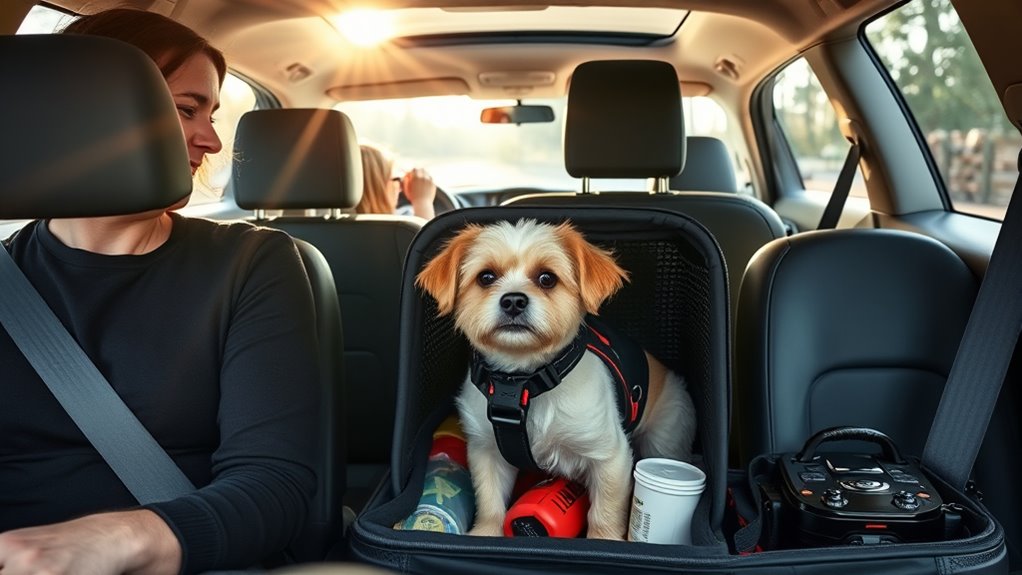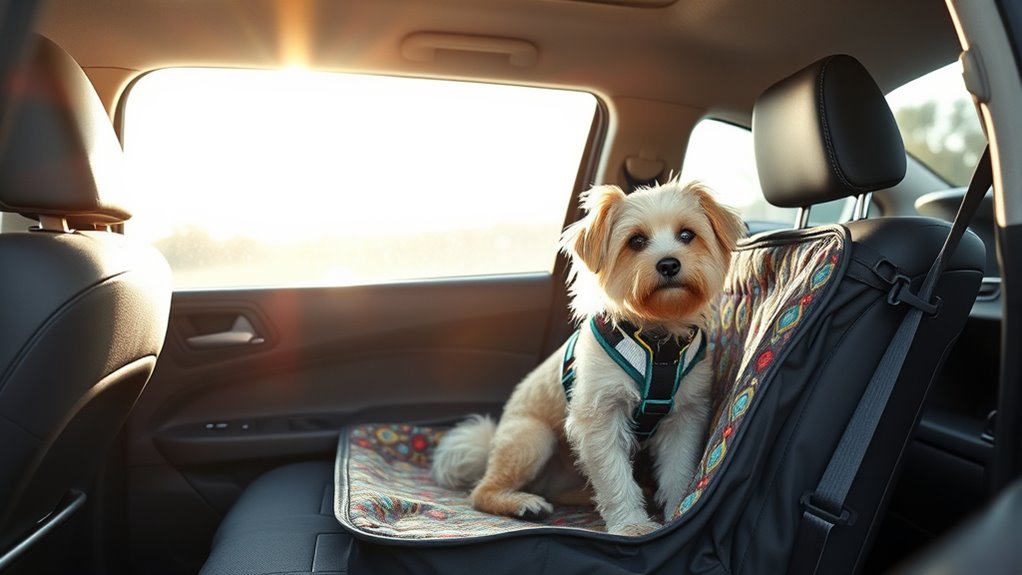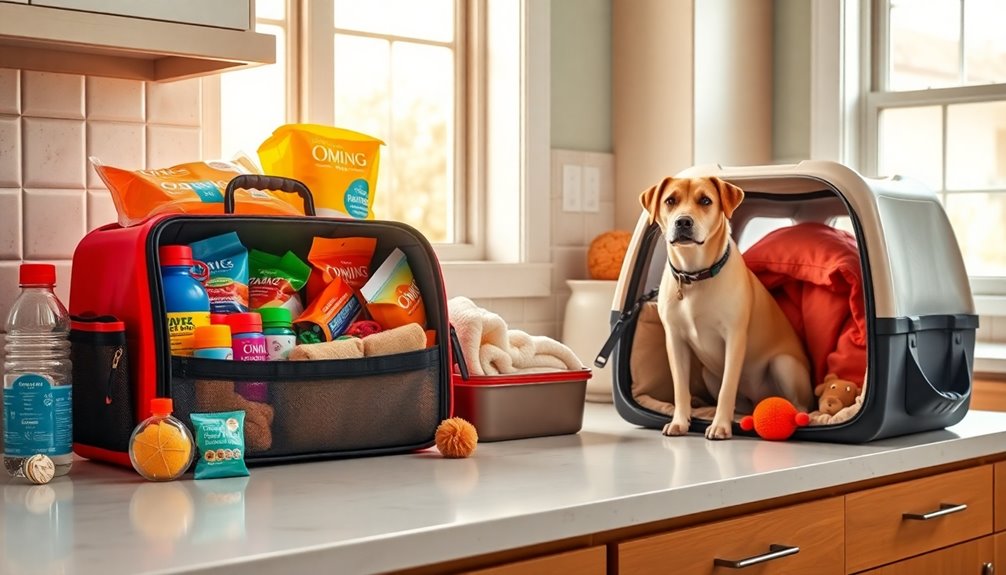To keep your pet safe during evacuations, use a well-ventilated crate or carrier to prevent injury and keep them secure. Attach harnesses to seatbelts to prevent movement and distraction. Keep calm and speak soothing words to reduce stress. Have familiar items with you to comfort them, and make certain your vehicle is calm and secure. For more tips on safely transporting pets during emergencies, continue exploring how you can prepare better.
Key Takeaways
- Use a well-ventilated, secure crate or carrier to keep pets safe and comfortable during travel.
- Attach harnesses to seatbelts to prevent movement and minimize distraction while driving.
- Secure pets before departure to prevent injuries or escapes during sudden stops or turns.
- Provide familiar items or calming words to reduce stress and anxiety during transportation.
- Keep emergency supplies, including water, food, and records, accessible for quick access if needed.

During evacuations, guaranteeing your pet’s safety in the car is essential, especially when time is limited and stress levels are high. Proper pet transportation during emergencies can make all the difference in keeping your furry friend safe and calm. Emergency preparedness involves more than just grabbing essentials; it requires a plan that includes how you’ll secure and care for your pet during transit. The chaos of an evacuation can be overwhelming, but having a strategy for safe transportation helps reduce panic and ensures your pet remains protected.
Ensuring pet safety during evacuations reduces stress and keeps your furry friend protected in emergencies.
Start by preparing a dedicated emergency kit for your pet that includes water, food, medications, and comfort items like a favorite blanket or toy. Having these essentials ready means you won’t waste precious time searching when seconds count. It’s also wise to keep a leash, harness, or carrier in an accessible spot in your home so you can quickly secure your pet when needed. A well-ventilated crate or carrier is ideal for pet transportation because it provides a secure space that prevents your pet from moving around and getting injured during sudden stops or turns. Additionally, understanding the importance of projector contrast ratio can help you select the best setup for your home cinema, ensuring clear images even in dark scenes.
When it’s time to evacuate, always prioritize your pet’s safety by securing them in the vehicle before leaving. Never let your pet roam freely in the car, as this can be dangerous for both of you. Use a harness attached to a seatbelt or place them in a carrier to prevent distractions while driving. This not only keeps your pet safe but also helps you stay focused on the road. Remember, pets can become distressed during evacuations, so comfort them with calm words or familiar items to help reduce anxiety.
Planning ahead for pet transportation also means knowing your options. If you’re in a wildfire zone or flood-prone area, consider arrangements with nearby friends, family, or local shelters that accept pets. Having a backup plan ensures you’re prepared if your primary route becomes inaccessible. Keep your pet’s emergency records, vaccination history, and identification tags up to date and accessible, so you can provide proof of ownership or medical needs if necessary.
Emergency preparedness includes practicing evacuation drills with your pet, so both of you are familiar with the process. This reduces panic during actual emergencies and helps you identify any adjustments needed for safer pet transportation. Having a clear plan, necessary supplies, and a calm approach will make your evacuation smoother and safer for your pet. Remember, being prepared isn’t just about your safety but also about ensuring your pet’s well-being during stressful times.
Frequently Asked Questions
How Can I Keep My Pet Calm During Stressful Evacuations?
To keep your pet calm during stressful evacuations, use pet calming techniques like playing soothing music or offering familiar toys. Practice anxiety reduction strategies such as gentle petting and calm voice commands to reassure them. Keep their crate or harness secure, and stay calm yourself, as your demeanor influences their stress levels. By staying composed and providing comfort, you help reduce their anxiety and make the evacuation process smoother for your furry friend.
What’s the Best Way to Secure Different Types of Pets in a Car?
You should use appropriate pet restraint systems tailored to your pet’s size and type, like harnesses, crates, or carriers, to keep them secure. Make certain your vehicle has good ventilation to keep your pet comfortable and prevent overheating. Always double-check that restraints are snug but not too tight, and secure them to prevent movement during sudden stops. Properly secured pets and proper ventilation make your evacuation safer and less stressful for everyone.
Are There Specific Travel Accessories Recommended for Pets?
Think of travel accessories as your pet’s travel toolkit. You should invest in sturdy travel harnesses to keep your pet secure and prevent them from becoming a flying furball. Portable water bowls are essential to keep your pet hydrated on the go. These accessories guarantee your pet’s safety, comfort, and hydration during your journey, making your trip smoother and less stressful for both of you.
How Often Should I Stop for Pet Comfort During Long Drives?
You should plan to stop every 2-3 hours for pet comfort during long drives. Rest stop frequency is key to preventing stress and discomfort. Use pet comfort tips like offering water, taking short walks, and checking on their well-being. These breaks give your pet a chance to stretch and relax, making the journey safer and more comfortable for both of you. Always keep an eye on their behavior for signs of fatigue.
What Should I Include in My Pet’s Emergency Travel Kit?
You should include essentials like pet first aid supplies, such as bandages and antiseptic, to handle minor injuries. Also, pack your pet’s travel documentation, including vaccination records and identification tags, for easy access and proof of ownership. Don’t forget extra food, water, and any necessary medications. Having these items ready helps keep your pet safe, comfortable, and prepared for emergencies during your journey.
Conclusion
Remember, your pet’s safety depends on proper preparation and calm travel. While it might seem easier to just throw them in the car and go, taking the time to secure them properly can prevent accidents and ensure a smoother evacuation. Some might think it’s unnecessary or time-consuming, but in emergencies, every second counts. Prioritize your pet’s well-being by planning ahead—because a safe journey means peace of mind for both of you.










